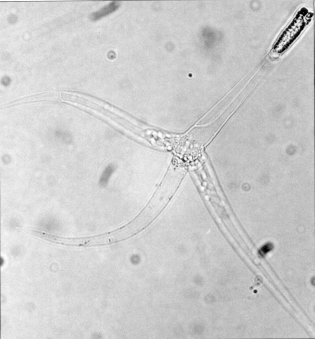
Myxozoa is a subphylum of aquatic cnidarian animals – all obligate parasites. It contains the smallest animals ever known to have lived. Over 2,180 species have been described and some estimates have suggested at least 30,000 undiscovered species. Many have a two-host lifecycle, involving a fish and an annelid worm or a bryozoan. The average size of a myxosporean spore usually ranges from 10 μm to 20 μm, whereas that of a malacosporean spore can be up to 2 mm. Myxozoans can live in both freshwater and marine habitats.

Myxobolus cerebralis is a myxosporean parasite of salmonids that causes whirling disease in farmed salmon and trout and also in wild fish populations. It was first described in rainbow trout in Germany in 1893, but its range has spread and it has appeared in most of Europe, the United States, South Africa, Canada and other countries from shipments of cultured and wild fish. In the 1980s, M. cerebralis was found to require a tubificid oligochaete to complete its life cycle. The parasite infects its hosts with its cells after piercing them with polar filaments ejected from nematocyst-like capsules. This infects the cartilage and possibly the nervous tissue of salmonids, causing a potentially lethal infection in which the host develops a black tail, spinal deformities, and possibly more deformities in the anterior part of the fish.

Myxobolus is a genus of myxozoa that includes important parasites of fish like Myxobolus cerebralis. The genus is polyphyletic, with members scattered throughout the myxozoa. Some stages of Myxobolus species were previously thought to be different organisms entirely, but are now united in this group. Some fish species, such as the thicklip grey mullet, can harbour a dozen of Myxobolus species.
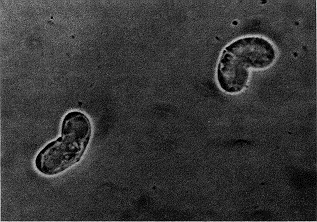
Ceratonova shasta is a myxosporean parasite that infects salmonid fish on the Pacific coast of North America. It was first observed at the Crystal Lake Hatchery, Shasta County, California, and has now been reported from Idaho, Oregon, Washington, British Columbia and Alaska.

Myxobolidae is a family of myxosporean parasites which typically infect freshwater fishes, and includes the economically significant species, Myxobolus cerebralis. They have been shown to have a complex life cycle, involving an alternate stage in an invertebrate, typically an annelid or polychaete worm.

Bivalvulida is an order of myxosporean parasites which contains a number of species which cause economically significant losses to aquaculture and fisheries, such as Myxobolus cerebralis and Ceratomyxa shasta. The Myxosporean stages of members of the bivalvulida are characterised by their two spore valves, which meet in a "suture line" which encircles the spore. They usually contain two polar capsules, but species have been reported which contain either one or four.
Tetracapsuloides bryosalmonae is a myxozoan parasite of salmonid fish. It is the only species currently recognized in the monotypic genus Tetracapsuloides. It is the cause of proliferative kidney disease (PKD), one of the most serious parasitic diseases of salmonid populations in Europe and North America that can result in losses of up to 90% in infected populations.
Kudoa thyrsites is a myxosporean parasite of marine fishes. It has a worldwide distribution, and infects a wide range of host species. This parasite is responsible for causing economic losses to the fisheries sector, by causing post-mortem "myoliquefaction", a softening of the flesh to such an extent that the fish becomes unmarketable. It is not infective to humans.
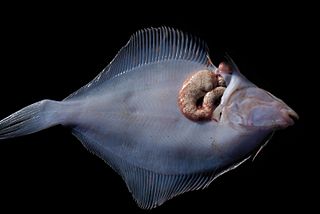
A xenoma is a growth caused by various protists and fungi, most notably microsporidia. It can occur on numerous organisms; however is predominantly found on fish.

Henneguya zschokkei or Henneguya salminicola is a species of a myxosporean endoparasite. It afflicts several salmon in the genus Oncorhynchus. It causes milky flesh or tapioca disease. H. zschokkei is notable for its lack of mitochondria, mitochondrial DNA, aerobic respiration and its reliance on an exclusively anaerobic metabolism.

Like humans and other animals, fish suffer from diseases and parasites. Fish defences against disease are specific and non-specific. Non-specific defences include skin and scales, as well as the mucus layer secreted by the epidermis that traps microorganisms and inhibits their growth. If pathogens breach these defences, fish can develop inflammatory responses that increase the flow of blood to infected areas and deliver white blood cells that attempt to destroy the pathogens.

Diseases and parasites in salmon, trout and other salmon-like fishes of the family Salmonidae are also found in other fish species. The life cycle of many salmonids is anadromous, so such fish are exposed to parasites in fresh water, brackish water and saline water.

Kudoa is a genus of Myxozoa and the only genus recognized within the monotypic family Kudoidae. There are approximately 100 species of Kudoa all of which parasitize on marine and estuarine fish. Kudoa are most commonly known and studied for the negative effects the genus has on commercial fishing and aquaculture industries.
Gadimyxa atlantica is a species of parasitic myxozoan. Together with G. arctica and G. sphaerica, they infect Gadus morhua and Arctogadus glacialis by developing coelozoically in bisporic plasmodia in their urinary systems. These 3 species' spores exhibit two morphological forms: wide and subspherical, being both types bilaterally symmetrical along the suture line. The wide spores have a mean width ranging from 7.5-10μm, respectively, while the subspherical ones range from 5.3-8μm in mean width. The subspherical forms of Gadimyxa are similar to Ortholinea, differing in the development of the spores and in the arrangement of the polar capsules. Polychaetes Spirorbisspecies act as invertebrate hosts of G. atlantica.
Gadimyxa sphaerica is a species of parasitic myxozoan. Together with G. arctica and G. atlantica, they infect Gadus morhua and Arctogadus glacialis by developing coelozoically in bisporic plasmodia in their urinary systems. These 3 species' spores exhibit two morphological forms: wide and subspherical, being both types bilaterally symmetrical along the suture line. The wide spores have a mean width ranging from 7.5-10μm, respectively, while the subspherical ones range from 5.3-8μm in mean width. The subspherical forms of Gadimyxa are similar to Ortholinea, differing in the development of the spores and in the arrangement of the polar capsules.
Gadimyxa arctica is a species of parasitic myxozoan. Together with G. atlantica and G. sphaerica, they infect Gadus morhua and Arctogadus glacialis by developing coelozoically in bisporic plasmodia in their urinary systems. These 3 species' spores exhibit two morphological forms: wide and subspherical, being both types bilaterally symmetrical along the suture line. The wide spores have a mean width ranging from 7.5-10μm, respectively, while the subspherical ones range from 5.3-8μm in mean width. The subspherical forms of Gadimyxa are similar to Ortholinea, differing in the development of the spores and in the arrangement of the polar capsules.
Kudoa paraquadricornis is a myxosporean parasite of marine fishes, first discovered in Australia from 4 carangid species.

Enteromyxum leei is a species of myxozoan, histozoic parasite that infects the intestinal tract and sometimes associated organs, like gall bladder and liver, of several teleostean fish species. Myxozoans are microscopic metazoans, with an obligate parasitic life-style. The parasite stages of this species live in the paracelullar space between fish enterocytes. It is the causative agent of enteromyxosis, or emaciative disease, also known as "razor blade syndrome" in sparid fish. E. leei has a wide host and geographical range within marine fish, and even freshwater fish have been infected experimentally. E. leei initially emerged in the Mediterranean in the late 1980s and it is believed to have been unintentionally introduced into the Red Sea. Its pathogenicity and economic impact depend on the host species. In the gilt-head seabream, it is manifested as a chronic disease that provokes anorexia, delayed growth with weight loss, cachexia, reduced marketability and increased mortality. In other species, it has no clinical signs. In sharpsnout seabream, infection results in very high mortality rates, which have pushed fish farmers to abandon the culture of this fish species.
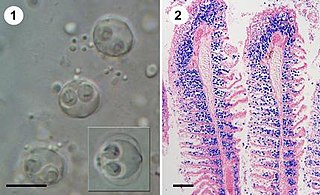
Sphaerospora molnari is a microscopic endoparasite of carp in pond cultures and natural freshwater habitats in Central and Eastern Europe. In natural infections, S. molnari invades the epithelia of gills and surrounding skin regions. It then forms spores in between epithelial cells, causing sphaerosporosis, a pathological condition of the skin and gill tissues. Affected tissues show marked dystrophic changes and necrosis, causing secondary bacterial infections and resulting in osmoregulatory and respiratory failure. Mortalities can reach 100% but little is known about the overall distribution of the parasite species in European carp ponds or its economic impact on carp aquaculture.
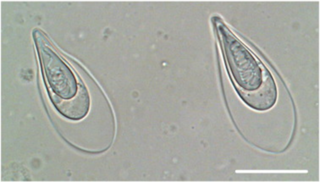
Thelohanellus kitauei is a myxozoan endoparasite identified as the agent of intestinal giant-cystic disease (IGCD) of common carp Cyprinus carpio. The species was first identified in Japan, in 1980 and later formally described by Egusa & Nakajima. Fan subsequently reported the parasite in China, and several other reports from carp and Koi carp in China and Korea followed. Reports referred to an intestinal infection, swelling and emaciation of fish due to blockage of the intestinal tract by giant cysts. The intestine of carp was believed to be the only infection site of T. kitauei until Zhai et al. reported large cysts of T. kitauei in the skin, with morphologically similar and molecularly identical spores. T. kitauei has been recognized as the most detrimental disease of farmed carp in Asia with around 20% of farmed carp killed annually. In 2014, the genome of T. kitauei was sequenced, and in 2016, its life cycle was found to include the oligochaete Branchiura sowerbyi. Infected oligochaete worms were first discovered in Hungary and raised concerns of the introduction of T. kitauei into European carp culture ponds, since it was believed to be endemic to Asia. However, the related disease (IGCD) has not yet been reported in Europe.












